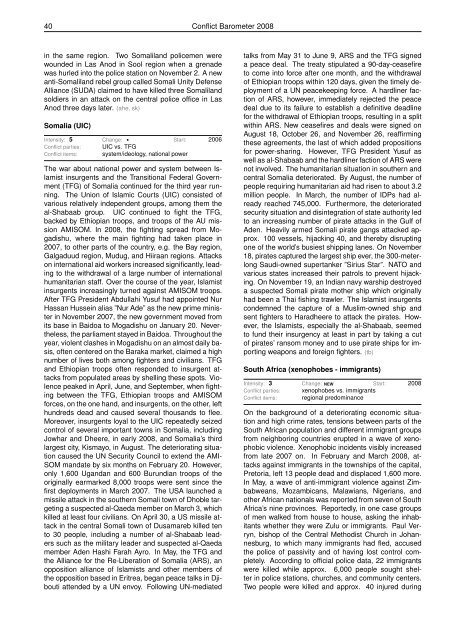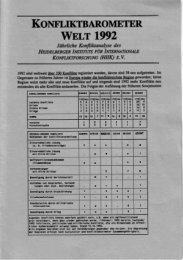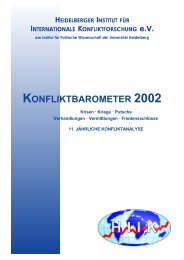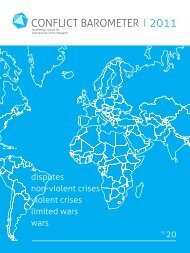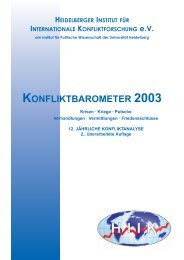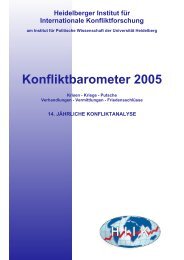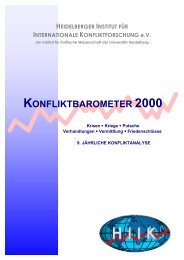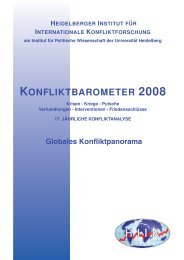CONFLICT BAROMETER 2008
CONFLICT BAROMETER 2008
CONFLICT BAROMETER 2008
You also want an ePaper? Increase the reach of your titles
YUMPU automatically turns print PDFs into web optimized ePapers that Google loves.
40 Conflict Barometer <strong>2008</strong><br />
in the same region. Two Somaliland policemen were<br />
wounded in Las Anod in Sool region when a grenade<br />
was hurled into the police station on November 2. A new<br />
anti-Somaliland rebel group called Somali Unity Defense<br />
Alliance (SUDA) claimed to have killed three Somaliland<br />
soldiers in an attack on the central police office in Las<br />
Anod three days later. (ahe, sk)<br />
Somalia (UIC)<br />
Intensity: 5 Change: Start: 2006<br />
Conflict parties: UIC vs. TFG<br />
Conflict items: system/ideology, national power<br />
The war about national power and system between Islamist<br />
insurgents and the Transitional Federal Government<br />
(TFG) of Somalia continued for the third year running.<br />
The Union of Islamic Courts (UIC) consisted of<br />
various relatively independent groups, among them the<br />
al-Shabaab group. UIC continued to fight the TFG,<br />
backed by Ethiopian troops, and troops of the AU mission<br />
AMISOM. In <strong>2008</strong>, the fighting spread from Mogadishu,<br />
where the main fighting had taken place in<br />
2007, to other parts of the country, e.g. the Bay region,<br />
Galgaduud region, Mudug, and Hiiraan regions. Attacks<br />
on international aid workers increased significantly, leading<br />
to the withdrawal of a large number of international<br />
humanitarian staff. Over the course of the year, Islamist<br />
insurgents increasingly turned against AMISOM troops.<br />
After TFG President Abdullahi Yusuf had appointed Nur<br />
Hassan Hussein alias ”Nur Ade” as the new prime minister<br />
in November 2007, the new government moved from<br />
its base in Baidoa to Mogadishu on January 20. Nevertheless,<br />
the parliament stayed in Baidoa. Throughout the<br />
year, violent clashes in Mogadishu on an almost daily basis,<br />
often centered on the Baraka market, claimed a high<br />
number of lives both among fighters and civilians. TFG<br />
and Ethiopian troops often responded to insurgent attacks<br />
from populated areas by shelling these spots. Violence<br />
peaked in April, June, and September, when fighting<br />
between the TFG, Ethiopian troops and AMISOM<br />
forces, on the one hand, and insurgents, on the other, left<br />
hundreds dead and caused several thousands to flee.<br />
Moreover, insurgents loyal to the UIC repeatedly seized<br />
control of several important towns in Somalia, including<br />
Jowhar and Dheere, in early <strong>2008</strong>, and Somalia’s third<br />
largest city, Kismayo, in August. The deteriorating situation<br />
caused the UN Security Council to extend the AMI-<br />
SOM mandate by six months on February 20. However,<br />
only 1,600 Ugandan and 600 Burundian troops of the<br />
originally earmarked 8,000 troops were sent since the<br />
first deployments in March 2007. The USA launched a<br />
missile attack in the southern Somali town of Dhoble targeting<br />
a suspected al-Qaeda member on March 3, which<br />
killed at least four civilians. On April 30, a US missile attack<br />
in the central Somali town of Dusamareb killed ten<br />
to 30 people, including a number of al-Shabaab leaders<br />
such as the military leader and suspected al-Qaeda<br />
member Aden Hashi Farah Ayro. In May, the TFG and<br />
the Alliance for the Re-Liberation of Somalia (ARS), an<br />
opposition alliance of Islamists and other members of<br />
the opposition based in Eritrea, began peace talks in Djibouti<br />
attended by a UN envoy. Following UN-mediated<br />
talks from May 31 to June 9, ARS and the TFG signed<br />
a peace deal. The treaty stipulated a 90-day-ceasefire<br />
to come into force after one month, and the withdrawal<br />
of Ethiopian troops within 120 days, given the timely deployment<br />
of a UN peacekeeping force. A hardliner faction<br />
of ARS, however, immediately rejected the peace<br />
deal due to its failure to establish a definitive deadline<br />
for the withdrawal of Ethiopian troops, resulting in a split<br />
within ARS. New ceasefires and deals were signed on<br />
August 18, October 26, and November 26, reaffirming<br />
these agreements, the last of which added propositions<br />
for power-sharing. However, TFG President Yusuf as<br />
well as al-Shabaab and the hardliner faction of ARS were<br />
not involved. The humanitarian situation in southern and<br />
central Somalia deteriorated. By August, the number of<br />
people requiring humanitarian aid had risen to about 3.2<br />
million people. In March, the number of IDPs had already<br />
reached 745,000. Furthermore, the deteriorated<br />
security situation and disintegration of state authority led<br />
to an increasing number of pirate attacks in the Gulf of<br />
Aden. Heavily armed Somali pirate gangs attacked approx.<br />
100 vessels, hijacking 40, and thereby disrupting<br />
one of the world’s busiest shipping lanes. On November<br />
18, pirates captured the largest ship ever, the 300-meterlong<br />
Saudi-owned supertanker ”Sirius Star”. NATO and<br />
various states increased their patrols to prevent hijacking.<br />
On November 19, an Indian navy warship destroyed<br />
a suspected Somali pirate mother ship which originally<br />
had been a Thai fishing trawler. The Islamist insurgents<br />
condemned the capture of a Muslim-owned ship and<br />
sent fighters to Haradheere to attack the pirates. However,<br />
the Islamists, especially the al-Shabaab, seemed<br />
to fund their insurgency at least in part by taking a cut<br />
of pirates’ ransom money and to use pirate ships for importing<br />
weapons and foreign fighters. (tb)<br />
South Africa (xenophobes - immigrants)<br />
Intensity: 3 Change: NEW Start: <strong>2008</strong><br />
Conflict parties: xenophobes vs. immigrants<br />
Conflict items: regional predominance<br />
On the background of a deteriorating economic situation<br />
and high crime rates, tensions between parts of the<br />
South African population and different immigrant groups<br />
from neighboring countries erupted in a wave of xenophobic<br />
violence. Xenophobic incidents visibly increased<br />
from late 2007 on. In February and March <strong>2008</strong>, attacks<br />
against immigrants in the townships of the capital,<br />
Pretoria, left 13 people dead and displaced 1,600 more.<br />
In May, a wave of anti-immigrant violence against Zimbabweans,<br />
Mozambicans, Malawians, Nigerians, and<br />
other African nationals was reported from seven of South<br />
Africa’s nine provinces. Reportedly, in one case groups<br />
of men walked from house to house, asking the inhabitants<br />
whether they were Zulu or immigrants. Paul Verryn,<br />
bishop of the Central Methodist Church in Johannesburg,<br />
to which many immigrants had fled, accused<br />
the police of passivity and of having lost control completely.<br />
According to official police data, 22 immigrants<br />
were killed while approx. 6,000 people sought shelter<br />
in police stations, churches, and community centers.<br />
Two people were killed and approx. 40 injured during


